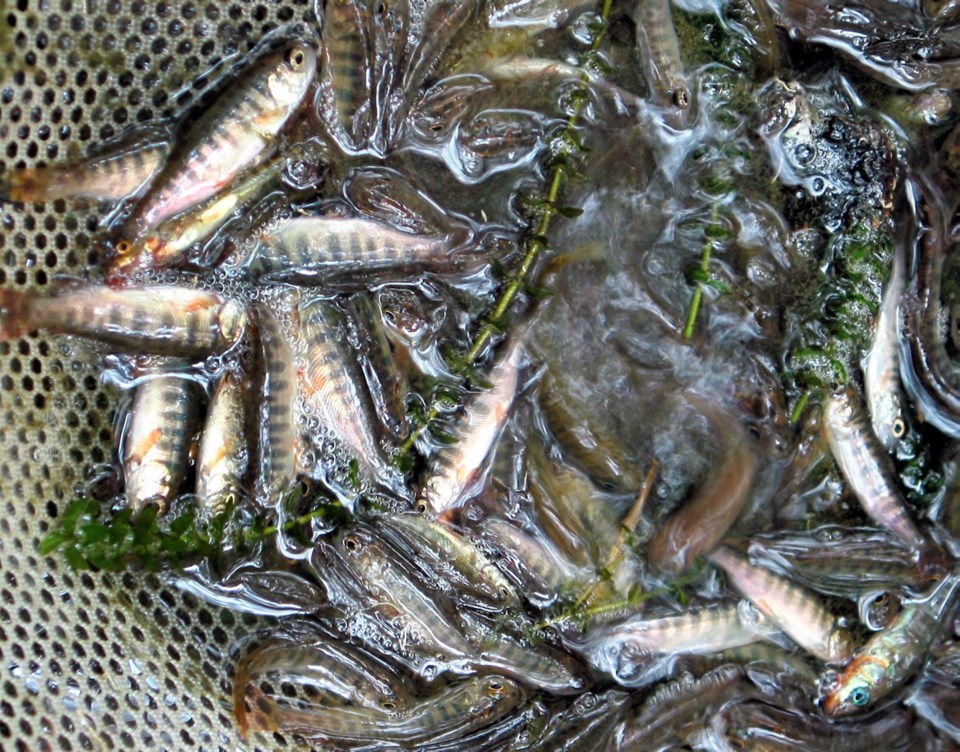When you think “river,” the image that might come to mind is of flowing open water. It might tumble and froth, or glide smoothly along — however it flows, you usually can see the water moving down the channel.
The Robertson River, which flows north into Bear Lake, then Cowichan Lake, has been flowing this summer, but since the spring, it’s been running mostly unseen, through layers of gravel.
Only pools of open water remain. Some big, some small, they provide refuge to the thousands of salmon and trout fry that hatched on the river this year. The river water seeping through cools the pools and brings oxygen that the young fish breathe.
“By the end of July, we expect the river to be running low,” says Parker Jefferson, who organizes the Cowichan River and Lake Stewardship Society’s fry rescue efforts. “What’s unusual this year is that the river’s levels dropped months earlier than usual.”
In March, instead of the river flowing two or three metres deep over the gravel bars, as is typical, the extreme drought the south Island experienced from February into April caused the river to contract and its surface to sink below the level of the gravel. On other rivers that feed into Cowichan Lake, the situation was even more dire, with no water flowing at all by May.
The year’s salmon hatch took a beating. Many areas where returning salmon had spawned last fall were left high and dry, with most of those eggs lost.
The fry that did hatch in the Robertson River have been stranded in the gravel pools, where they’re easy pickings for gulls, eagles, and other birds.
“I’ve even seen robins pulling fry out of the water this year — that’s how easy it is to catch the fish,” Jefferson says.
He and other volunteers from the area, as well as local First Nations, have been out a number of times recently, scooping stranded fry into buckets and releasing them downstream into Bear Lake. When I talked to Jefferson a couple of weeks ago, he’d just returned from the river. He and the stewardship society’s shoreline restoration crew had moved 2,000 coho and 100 cutthroat fry to safety in Bear Lake. He estimated that about 30,000 fry had been rescued from the river this year — just one-third the number rescued in “normal” years during the past decade.
“By July, there’s not a lot of water left in the river, so we’ve usually had to rescue fry,” he said. This year, the rescue efforts will be critical for the year’s young.
The Robertson River is not the river it once was for the fish that rely on it.
As predicted under climate-change assessments for the region, weather patterns have become more extreme. Instead of rain and snow falling regularly and steadily from October until June, most of the year’s rain buckets down during a couple of big storms in the fall. The river channel fills quickly. The sudden rush of high water erodes the banks, sending gravel and sediment downstream.
Logging on the surrounding mountains has also changed how water flows into the river. Forests break rain’s pounding impact and help the ground absorb water, then release it slowly over days and weeks. Without a forest to disrupt and sponge up water during heavy rains, more dirt and rocks wash into the river, more erosion occurs along the riverbanks and more gravel piles up.
Thirty years ago, Robertson River salmon and cutthroat fry might have had to contend with summer drought on the river, but five-centimetre-long fish can navigate in eight cm of water flowing over bedrock.
They cannot, however, swim through the metre-high gravel bars that now block their route into Lake Cowichan.
On the positive side, Jefferson says that, “the fish that have survived in these pools to this point this year are really fit. They’re big, fat and healthy. If we can just get them down to the lake, they stand a really good chance of being able to handle whatever the lake throws at them until they’re ready to head out to sea.”



